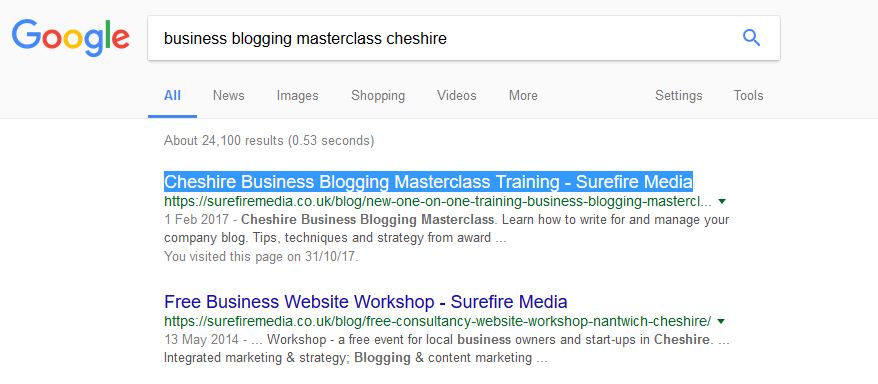Search Engine Optimisation is complex and ever-changing, typically taking years to fully master. In this article I focus on 6 basic SEO tips suitable for business and individual bloggers that are quick and easy to implement.
With more than 200 recognised ranking ‘signals’ in play, quite simply, the more ticks in those ranking signal boxes you have, the more likely you are to rank well in organic Google search.
Thankfully over the last 5 years we’ve seen a big shift away from dodgy ‘black hat’ tactics, and as Google’s various algorithms have evolved, so has SEO, making a more sustainable quality content-first approach necessary.
Who am I to tell you how to blog?
I’ve been blogging for businesses for the past 10 years, I blog here at Surefire and I have my own award-winning blog which has very quickly grown to attract over 90,000 unique monthly visitors.
My articles rank very highly in Google search, I’ve even bagged several of Google’s hallowed featured search snippets. I’ve achieved this by writing quality content that I’ve fully search engine optimised, and it’s all been done organically, with no additional advertising or P.P.C spend at all. Cool huh?
In a nutshell, my approach to SEO simply adheres to Google’s search quality guidelines and underpinning everything I do, is the belief that a website or blog should be full of useful content that demonstrates the expertise of an individual or business.
Getting started with the basics of optimising blog posts
One of the most basic starting points for any blogger or business owner responsible for writing for their blog, is to ensure that the copy you produce adheres to basic SEO best practice.
After all, there is no point writing content that your clients or customers will never actually see and likewise, you might have an informative and useful article that your clients or customers love, but if your SEO isn’t up to scratch, that content is unlikely to be seen by a wider audience, meaning you could miss out on attracting new readers, and in turn potential new business.
Which blogging platform is best?
I get asked this question a lot, so I’m not going to pull any punches on this one. Quite simply, Blogger.com is poor and WordPress.org is much better, and always my top recommendation. The SEO options you get with Blogger.com are very basic and just can’t compete with WordPress in my opinion.
Despite Shopify rising in popularity (and rightly so, it’s a great eCommerce platform) the built-in blog functionality is lacking and integrating a WordPress blog is definitely a superior option.
Don’t worry, I’m not some crazy blinkered evangelist, there are some clear downsides to WordPress. From security flaws if you don’t update plugins regularly, bloated themes and slow to load pages, to plugins that don’t work properly or are poorly supported, but on the whole, it’s pretty good.
When it comes to getting your blog posts to rank well, WordPress used in conjunction with the Yoast SEO plugin, have proved invaluable for my own blog and for the many clients I’ve written for over the years.
6 SEO Basics for Bloggers
1. Craft compelling, informative headlines and use a H1 heading tag
Your headline is important. Really Important. Think for a moment about the title of this very post you’re reading now.
“SEO Blogging Basics – How to Search Engine Optimise A Blog Post”
I could have called the post “SEO basics”, “SEO for blogging” or any number of less informative variations. I chose a title that immediately explains exactly what this post is about and importantly, part of my heading is a potential phrase match for the type of longtail keyword search people are likely to make on Google.
For example, if you are looking for tips, it stands to reason that you might Google “how to” followed by the topic or thing you want to learn about.
When it comes to headings then, include keywords that will match with people’s searches, and make your heading interesting and informative enough to give people a reason to click or continue reading.

The H1 heading is super important, as it gives Google critical information about the content of your page. If you are using WordPress, depending on the theme, your blog post title is very likely to be formatted as a H1 by default, but it’s worth checking, and also, make sure you don’t use more than one H1 tag on a page, as this confuses Google and will actively hinder your SEO attempts.
2. Write content that’s relevant and useful to your target audience
Relevance in terms of SEO is an important ranking signal. The more you write about similar and related topics, the more helpful this will be in terms of building authority. For Google to rank you well, it needs to be convinced that you are an expert or ‘authority’ in a particular area.
Use Moz Open Site Explorer to see what the Domain and Page Authority of any given page are, this will give you some basic idea of how well your site could rank in search. The higher your score, the more likely you are to rank better in Google search.
Make sure your content is relevant by thinking about who your customers are, understanding their pain points, answering the questions they often ask and highlighting the benefits that your service or products provide. You can also write about company news, produce detailed ‘how-to’ guides, provides tips and advice, factsheets, case studies, detailed brand, range or product profiles, customer reviews and testimonials….For more options on what to blog about, check out 30 content ideas to kick start your business blog.
3. Use small paragraphs, sub-headings and bullet points to engage your reader
Let’s start with sub-headings which are a great way of breaking up content, and they also have some benefit in terms of SEO, as Sub-headings should use H2, H3 and so on tags to give Google additional information.
Unlike the H1 tag, you can have as many as H2 and H3 tags as you want, but again, make sure that the sub-heading provides useful information for readers as well as important keywords.
In one of my favourite books called The Shallows, how the internet is changing the way we think, author Nicolas Carr argues that our brains are rewiring themselves now that most of our information is disseminated by the internet, and so the way we consume content has changed.
In simple terms this means people now have much shorter attention spans and simply will not read vast swathes of text.
Website visitor stats and heatmap experiments that monitor behaviour back this theory up, showing that people are more engaged when content is split up into more paragraphs, when lists and bullet points are used, when there are sub-headings to further break up content, and finally and perhaps most crucially, when there are plenty of pictures used.
Keeping readers on your page for longer once again is an SEO ranking signal; if people stay on a page for a few minutes indicating they have read your content and are engaged, this sends a positive message back to Google.
If you don’t already, then you really should have Google Analytics installed on your website/blog. It’s a free stats programme that will give you a great amount of insight into how long people are staying on each page of your website, as well as lots of other fascinating insights into visitor behaviour.
4. Optimise your images
It goes without saying that images are important, and your blog post should have at least one. Breaking up copy with more images is the smartest move however and you should ensure each image is fully optimised.

There are two main things you need to do to optimise your images;
- Make sure you name the files in a logical, informative way e.g. DC381730.jpg is frankly useless and should become something keyword based like topic_keyword_picture_title.jpg.A well optimised image is very likely to be included in Google Image Search too, giving you another potential route for people to discover your content.
- When you insert an image into a blog post you have the ability to enter an ‘ALT’ tag (alternative image tag). These are technically for screen readers, but can be utilised for SEO purposes too, your ALT tag should essentially be a succinct description describing the picture you’ve used. In the WordPress media library, you can go through each image you’ve uploaded and save a corresponding ALT tag.
5. Optimise your META title and description
Your META title is particularly important and if you aren’t sure what it is, it’s the title that Google uses to make sense of the content on your page. When you open up a browser tab, the tab will have some writing in it that you’ll only partly be able to read; that’s the META title. The META title is also generally the big blue headline that you see appear in search results.

If you want to see the META title in full right click on a web page, and click ‘view page source’. You’ll get a bunch of code appear. Do a search for the word meta name=”title” and there you will see the full title that Google uses.
Wordpress and Blogger will usually auto generate a META title and sometimes a description too, but you should ALWAYS manually edit it.
Sometimes your actual page title will be too long and won’t work well as a META title. Other times, you might have important keywords towards the end of your page title, in which case you might want to re-write your META title to bring the more important keywords to the start of the title. You might also want to remove low value or stop words from the META title so you aren’t wasting valuable characters with words that won’t provide you with much SEO benefit.
6. Content amplification is critical to reach more people
One of the ranking signals that Google looks at are backlinks, also known as citations. Put simply this is an incoming link from another website, blog or social media channel.
If an article you publish is well received, people are likely to be posting links to your article on their social media profiles, referencing and linking back to your post and saving it to places like Pinterest, Flipboard and StumbleUpon.
The more backlinks, the better as a rule, but, and it’s a big but, quality and relevance is key. Spammy backlinks from low authority sources won’t do you any good (too many can even garm your SEO), so go for quality over quantity.
Even the best blog post needs people to see it, and whilst you may have blog subscribers or customers who might stumble across your post, how do you get that post seen by more people?
There are lots of techniques and tools that can be used to increase the reach of your content, but the easiest way is to use social media. Once your blog post has been optimised and published, your next job is to then post about the new article across all of your social media channels, to help increase the chances of people spotting it, and don’t forget to post new blog articles on Google My Business too!
This is just a very basic guide, but you can find a comprehensive guide to SEO here.
Benefit from our content writing expertise
Whether it’s content for your website or you need someone to keep your blog updated, we can help. Get in touch with us for a natter about how we can help you.